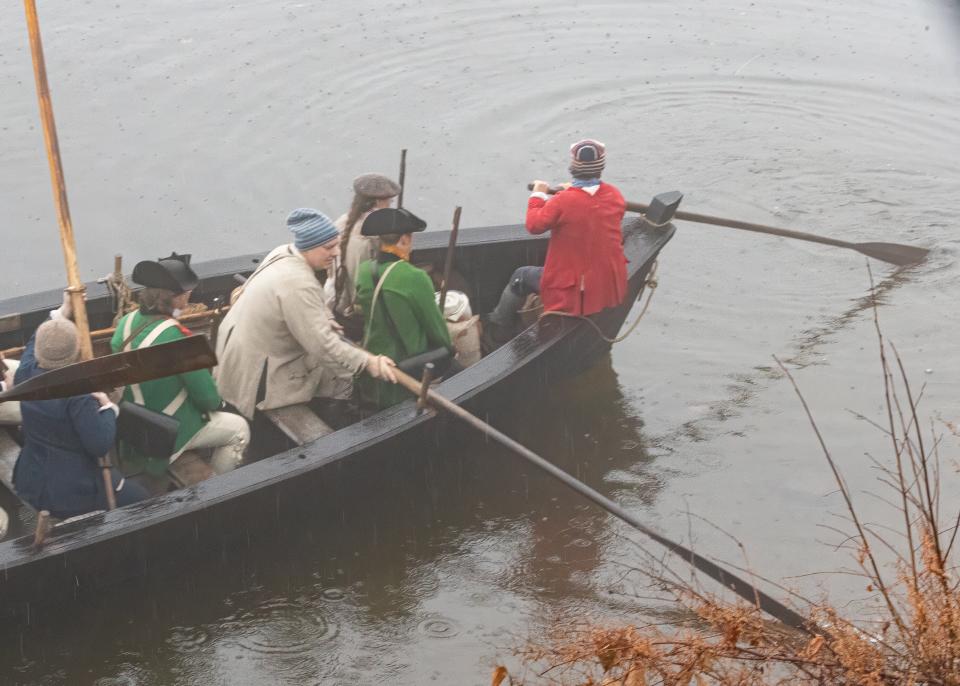Heroism took its toll on this Bucks County patriot in the American Revolution
- Oops!Something went wrong.Please try again later.
Every year about this time, we are reminded of George Washington’s fabled crossing of the Delaware from Upper Makefield to turn the American Revolution in favor of the new nation. Stories of heroism abound, especially in the early days when all was in doubt.
I recently turned up the story about one such hero. It’s a tale of self-sacrifice willingly entered on a gambit by Washington. As commander of the Continental Army fighting the Brits around Boston, he knew he didn’t have enough soldiers in the summer of 1776 to take on British garrisons spread about in the colonies. So, he created a “Flying Camp”. It was a French tactic of cavalry soldiers “always in motion to cover its own garrisons, and to keep the enemy’s army in a continual alarm,” as the general put it. He asked the colonies to provide 10,000 horse soldiers, 6,000 from Pennsylvania. Their mission was to deploy widely and threaten surprise attack on British Redcoats and German mercenaries wherever found.

In Bucks County, 400 citizens formed Col. Joseph Hart’s Bucks County Flying Camp Battalion. In Berks, 666 men flocked to form its Flying Camp. Perhaps because Bucks’ quota was filled, young farmer Isaac Lewis, 24, of Hilltown enlisted in the Berks battalion. In doing so, he left behind his wife, child, and family farm.
More: The failure of youth hostels in two state parks in Bucks County
With no uniforms available, Washington ordered the new soldiers to wear “hunting shirts and breeches as a cheap and convenient dress, and as one which might have its terrors for the enemy.” Occupying soldiers, according to the general, would believe “that every rebel so dressed was a ‘complete marksman.’”
One month after the colonies declared independence on July 4, 1776, Isaac and the Berks Flying Camp arrived in Long Island to try and stymy an anticipated English invasion of New York City. He watched from the heights that August 1776 as 35 warships and 400 transports bearing 35,000 troops arrived in New York Bay from England, the Mediterranean, the West Indies and Florida. It was the largest invasion force ever mobilized in the Western Hemisphere. Washington’s army at half that strength was unable to thwart landings at so many beachheads.
Isaac and his unit rode to Flatbush to burn stacks of grain held by British soldiers. The Americans engaged them with gunfire, driving them back. As Isaac lit the grain, a bullet tore through his right thigh, severing ligaments. It took great bravery for colleagues to rescue him. Overwhelmed by the invasion, Washington lost half his army. The injured, including Isaac, were born away in the retreat to New Jersey and safety in Bucks County. There the remaining army rebounded in Upper Makefield. Accompanied by 400 Flying Camp soldiers, the commander recrossed the river on Christmas night to rout the British in Trenton and reinvigorate the Revolution.
After extended treatment, Isaac rejoined his outfit at Valley Forge in 1777. However, his crippled condition made him unfit for further duty. He returned him home permanently disabled, his right leg shorter than his left. As historian Donald B. Lewis put it, “Lewis became a shoemaker, and spent the remainder of his days hobbling with a crutch about the byways of Hilltown Township.”
In 1819, the federal government denied him increased pension benefits on the grounds the Flying Camp was not part of the regular Continental Army. Two years later, Isaac died in poverty at age 70. His personal property consisted of his clothes, a table, bed and bedding, knife, spectacles, two books and planted corn. Net worth: $176. Today a weathered, engraved tombstone in the Hilltown Lower Baptist Church cemetery celebrates Isaac Wilson’s life: “Soldier in Revolutionary Army under General Washington.”
Sources include “One Soldier’s Story: Isaac Lewis of the Flying Camp, 1776” by Donald B. Lewis published in 2018 in the Journal of the American Revolution, and “A successful failure” by Richard Baker published July 8, 2010 by the U.S. Army Military Institute. George Washington’s incredible crossing of the Delaware will be reenacted at 1 p.m. on Christmas Day on both sides of the river. Details on the web at www.washingtoncrossingpark.org/park/crossing-reenactment/
Carl LaVO can be reached at carllavo0@gmail.com
This article originally appeared on Bucks County Courier Times: Heroism took its toll on a Bucks County patriot in Revolutionary War

